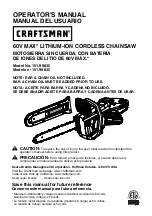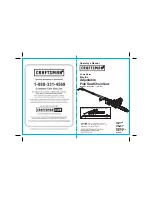
16 ENGLISH
Sharpen the saw chain when:
— Mealy sawdust is produced when damp wood is
cut;
— The chain penetrates the wood with difficulty, even
when heavy pressure is applied;
— The cutting edge is obviously damaged;
— The saw pulls to the left or right in the wood. The
reason for this behaviour is uneven sharpening of
the saw chain, or damage to one side only.
Sharpen the saw chain frequently, but
remove only a little material each time.
Two or three strokes with a file are usually sufficient for
routine resharpening. When the saw chain has been
resharpened several times, have it sharpened in a
MAKITA specialist repair shop.
Sharpening criteria:
— All cutter length must be equal. Cutters of differing
length prevent the chain from running smoothly,
and may cause the chain to break.
— Do not sharpen the chain once a minimum cutter
length of 3 mm has been reached. A new chain
must then be fitted.
— The chip thickness is determined by the distance
between the depth gauge (round nose) and the
cutting edge.
— The best cutting results are obtained with following
distance between cutting edge and depth gauge.
Chain blade 90PX: 0.5 mm
Chain blade 91PX: 0.65 mm
Chain blade 25AP: 0.65 mm
►
Fig.28:
1.
Cutting length
2.
Distance between
cutting edge and depth gauge
3.
Minimum
3 mm
WARNING:
•
An excessive distance increases the risk of
kick-back.
— The sharpening angle of 30 ° must be the same
on all cutters. Differences in angle cause the chain
to run roughly and unevenly, accelerate wear, and
lead to chain breaks.
— The side plate angle of the cutter is determined
by the depth of penetration of the round file. If the
specified file is used properly, the correct side
plate angle is produced automatically.
— Side plate angle for each saw chain are as follows:
Chain blade 90PX: 75 °
Chain blade 91PX: 80 °
Chain blade 25AP: 85 °
►
Fig.29:
1.
Side plate angle
File and file guiding
— Use a special round file (optional accessory) for
saw chains to sharpen the chain. Normal round
files are not suitable.
— Diameter of the round file for each saw chain is as
follows:
Chain blade 90PX: 4.5 mm
Chain blade 91PX: 4.0 mm
Chain blade 25AP: 4.0 mm
—
The file should only engage the cutter on the forward
stroke. Lift the file off the cutter on the return stroke.
— Sharpen the shortest cutter first. Then the length
of this shortest cutter becomes the standard for all
other cutters on the saw chain.
►
Fig.30
— Guide the file as shown in the figure.
—
The file can be guided more easily if a file holder
(optional accessory) is employed. The file holder has
markings for the correct sharpening angle of 30 ° (align
the markings parallel to the saw chain) and limits the
depth of penetration (to 4/5 of the file diameter).
►
Fig.31
— After sharpening the chain, check the height of the
depth gauge using the chain gauge tool (optional
accessory).
►
Fig.32
— Remove any projecting material, however small,
with a special flat file (optional accessory).
— Round off the front of the depth gauge again.
Cleaning guide bar
►
Fig.33
Chips and sawdust will build up in the guide bar groove,
clogging it and impairing oil flow. Always clean out the chips
and sawdust when sharpening or replacing the saw chain.
Cleaning the oil discharge hole
Small dust or particles may be built up in the oil dis-
charge hole during operation.
Small dust or particles built up in the oil discharge hole
may impair the oil discharge flow and cause an insuffi
-
cient lubrication on the whole saw chain.
When a poor chain oil delivery occurs at the top of
guide bar, clean the oil discharge hole as follows.
Remove the battery cartridge from the tool.
Remove the sprocket cover and saw chain from the
tool. (Refer to the section titled " Installing or removing
saw chain ".)
►
Fig.34:
1.
Slotted screwdriver
Remove the small dust or particles using a slotted
screwdriver with a slender shaft or the like.
Insert the battery cartridge into the tool.
Pull the switch trigger to flow built-up dust or particles
off the oil discharge hole by discharging chain oil.
Remove the battery cartridge from the tool.
Reinstall the sprocket cover and saw chain on the tool.
Replacing the sprocket
►
Fig.35:
1.
Sprocket
2.
Locking ring
Before fitting a new saw chain, check the condition of
the sprocket.
CAUTION:
•
A worn sprocket will damage a new saw chain.
Have the sprocket replaced in this case. The
sprocket needs to be installed so that it always
faces as shown in the figure.
►
Fig.36:
1.
Locking ring
2.
Sprocket
Always fit a new locking ring when replacing the
sprocket.
Summary of Contents for DUC302RF2
Page 2: ...1 2 3 1 1 1 2 1 2 1 2 3 1 Fig 1 Fig 2 Fig 3 Fig 4 Fig 5 Fig 6 Fig 7 Fig 8 2 ...
Page 3: ...2 1 1 1 1 1 2 2 1 2 1 Fig 9 Fig 10 Fig 11 Fig 12 Fig 13 Fig 14 Fig 15 Fig 16 3 ...
Page 4: ...1 2 3 4 5 2 1 1 3 2 1 1 2 Fig 17 Fig 18 Fig 19 Fig 20 Fig 21 Fig 22 Fig 23 Fig 24 4 ...
Page 5: ...2 1 2 2 1 1 3 1 30 30 1 1 30 Fig 25 Fig 26 Fig 27 Fig 28 Fig 29 Fig 30 Fig 31 Fig 32 5 ...
Page 6: ...1 1 2 1 2 1 2 1 Fig 33 Fig 34 Fig 35 Fig 36 Fig 37 Fig 38 6 ...
Page 47: ...47 ...
















































